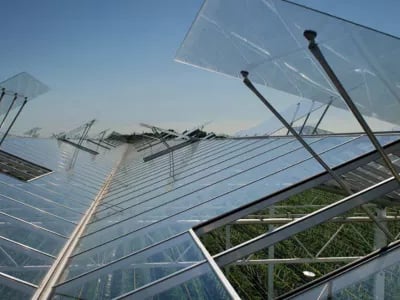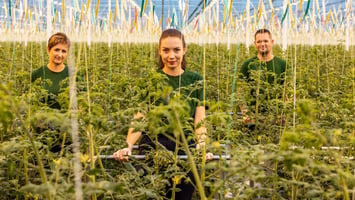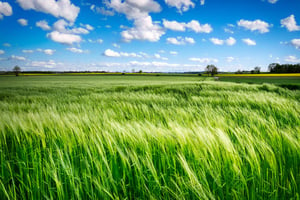The global market for greenhouses – for the growing of vegetables, plants, and flowers – is expanding rapidly. More and more crops that are traditionally grown ‘in the open ground’ are now finding their way to so-called ‘protected crop cultivation’. What are the economic and other reasons behind this trend? And given the further anticipated expansion of the global population in the coming decades, should greenhouses be viewed as ‘the way to growth’? Rutger Ruigrok, NPM Capital's managing director, discussed these questions with Wouter Kuiper, CEO of high-tech greenhouse builder KUBO.
Ruigrok: “You were born and raised in the Westland [editor's note: the main greenhouse horticultural region in the Netherlands]… It would be surprising if you didn't believe in a bright future for greenhouse horticulture.”
Kuiper: “You're right, that wouldn't be what you'd expect to hear. On the other hand, although a lot of innovation is happening in the Westland region, we're not necessarily seeing much expansion of greenhouses. That ecosystem is more or less 'complete'. If we're talking about the future of greenhouse horticulture, that lies beyond our national borders. There is a rapidly growing global demand for high-quality and locally grown products that are grown safely and efficiently under ideal climatological conditions, using limited energy, water and pesticides. Greenhouses are basically the only way to do that.”
Ruigrok: “In school, many of us were told that greenhouses emerged to reduce farmers' dependence on the seasons. Is that still the case?”
Kuiper: “That is how it started long ago – there was a time when we even grew melons in the Westland. Today, the calculus has changed significantly. More and more crops are moving from the open ground into greenhouses, and there are multiple reasons for that. A very important one is that horticulture in the open ground takes a lot of space. That isn't a problem everywhere on Earth, but it certainly is in many places, and besides, enormous areas of woodland are razed to make space for agriculture. Secondly, open-ground cultivation requires a lot of irrigation, and water can be scarce in many places. Third, the yield will be relatively low, unless you use generous amounts of crop protection products, which has unintended negative side effects on the environment. So when you add up those reasons, greenhouses become the rational choice in many cases.”
Ruigrok: “Can you give us an example of that?”
Kuiper: “In the US, large acreages of tomatoes are still grown in the open ground. In greenhouses, you could quadruple the yield per square metre with only some five percent of the water consumption and a negligible amount of crop protection products.”
No crystal ball
Ruigrok: “Are all crops suitable for cultivation in greenhouses? What about bulk crops like wheat and potatoes?”
Kuiper: “Of course, I don't have a crystal ball, but I can say it will depend on what's economically viable. First of all, 'greenhouse' is an elastic concept that might vary from a simple wire mesh box of a few dollars per square metre, to medium-tech foil greenhouses, to high-tech glass greenhouses like we are developing. The latter are only five percent of the market right now, and they are primarily used for fragile types of fruits and vegetables with a solid consumer margin. But the cheaper kinds of greenhouses can easily be used for the cultivation of, say, kale or spinach, which are still seen as typical outdoor vegetables. Especially if further innovation brings us varieties with shorter growth cycles, for example. Greenhouses offer a lot of options, but the total picture needs to fit. And the total picture includes sustainability questions, as well. To return to those melons I mentioned earlier: they are no longer grown in the Westland, but in Costa Rica, because you get many hours of sunshine there and the labour is cheap. But after the harvest, those melons need to travel a very long distance to get to us. You would need to compare the ‘true price’ of such a melon to the price of a local greenhouse-grown melon. Those kinds of discussions have not yet reached a critical mass, but it is a valid question whether we will still find it acceptable ten years from now to import melons from so far away.”
Ruigrok: “What is your view on the impacts of climate change? Because the ideal climate to grow melons in today, may look quite different in ten years...”
Kuiper: “That's correct. The impact of climate change is growing. It's not self-evident that outdoors cultivation will still be profitable ten years from now in places where it is profitable today. For that reason, we have spent the past few years developing a greenhouse concept that allows for the cultivation of high-quality products in literally any region in the world. From the North Pole to the Equator. Of course, you will need heating and cooling, so there is a price tag attached to it. But the same applies to the alternatives, like importing products from other regions.”
Groundbreaking concepts ahead
Ruigrok: “Is scale an important factor in these questions?”
Kuiper: “Certainly. It has always been important, but it is clearly becoming even more so. We can see that the scale at which our clients operate is getting larger and larger, and the greenhouses are not only getting bigger, but also increasingly complex technologically. In addition, a growing number of investors are entering the market lacking horticultural expertise themselves and looking for turn-key solutions. Their thinking happens on a very different scale than those traditional family businesses that used to dominate the industry. And that development is happening all over the world.”
Ruigrok: “We are also seeing agriculture moving away from countries like Spain because the costs of labour have risen significantly. Does greenhouse horticulture also require less manual labour?”
Kuiper: “There is no major difference between plucking tomatoes in a field and plucking tomatoes in a greenhouse, although the work environment in greenhouses does tend to be more pleasant. I do think that greenhouse horticulture offers better opportunities for robotisation, since robots are more effective in stable conditions. So in the future, the difference in labour costs may grow. And if we think a little further ahead, I think we will see some groundbreaking concepts using Artificial Intelligence and Machine Learning in the future. At KUBO, we are already thinking about a greenhouse capable of making autonomous decisions about light, temperature, CO2, irrigation, and fertilisation. That would be a greenhouse that can deliver a consistently predictable output while requiring as little human intervention as possible. Right now, that is still a bit of a pipe dream, but we are headed in that direction.”













